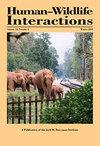比利时法兰德斯野猪:主要利益相关者就野猪管理目标、行动和法律规定达成的协议
IF 0.9
4区 环境科学与生态学
Q4 BIODIVERSITY CONSERVATION
引用次数: 2
摘要
在消失了半个多世纪之后,野猪于2006年在比利时的佛兰德斯重新出现。在欧洲,野猪不仅是一种珍贵的本地狩猎物种,而且在高密度的情况下,野猪也会造成汽车碰撞、农作物破坏、疾病传播和生态破坏。因此,野猪的管理寻求平衡这些积极和消极的影响。考虑到法兰德斯高度分散的景观及其多功能用途,只有通过涉及相关利益相关者群体的综合管理,才能与野猪共存。然而,要取得成功,这需要管理目标、佛兰德当局的整体野猪政策和管理行动得到利益相关者的支持。为了评估对当前管理的支持程度,我们在三个主要利益相关者群体中进行了调查:农民、猎人和保护主义者。我们的调查评估了利益相关者对不同管理目标的重要性,他们对现行法律规定的支持,以及不同利益相关者群体对可能的管理行动的期望程度。潜在冲突指数用于分析利益相关者群体之间和内部的(不)协议。所有3个利益相关者团体都指出,减少或防止作物损害和车祸风险是最重要的管理目标。利益相关者群体对现行法律规定的支持存在很大差异。那些必须执行法律规定或主要受这些法律影响的利益相关者比其他人更不支持。根据不同的利益相关者群体,可能的管理行动的可取性有很大的不同。与其他研究相反,可能的管理行动的可取性几乎不受其试图实现的管理目标的影响。本文章由计算机程序翻译,如有差异,请以英文原文为准。
Wild Boar in Flanders, Belgium: (Dis)agreements Between Key Stakeholders on Wild Boar Management Objectives, Actions, and Legal Provisions
Wild boar (Sus scrofa) reappeared in Flanders, Belgium in 2006 after more than half a century of absence. Besides being a native and highly valued game species in Europe, wild boar are also known to be responsible for car collisions, crop damage, disease transmission, and ecological damage at high densities. The management of wild boar therefore seeks to balance these positive and negative impacts. Given the highly fragmented landscape in Flanders and its multifunctional use, coexistence with wild boar is only possible through integrated management involving relevant stakeholder groups. However, to be successful, this requires that the management objectives, the overall wild boar policy of the Flemish authorities, and management actions are supported by the stakeholders. To assess the support for the current management, we conducted a survey among members of the 3 key stakeholder groups: farmers, hunters, and conservationists. Our survey assessed the importance stakeholders attribute to different management objectives, their support for the current legal provisions, and how desirable the different stakeholder groups considered possible management actions. The potential for conflict index was used to analyze the (dis)agreement between and within stakeholder groups. Reducing or preventing crop damage and the risk for car accidents are indicated as being the most important management objectives by all 3 stakeholder groups. Stakeholder groups differ strongly in their support for the current legal provisions. Those stakeholders that have to implement the legal provisions or are mostly affected by these laws are less supportive than others. The desirability of the possible management actions strongly varied according to the different stakeholder groups. Contrary to other studies, the desirability of a possible management action was hardly influenced by the management objective it tried to achieve.
求助全文
通过发布文献求助,成功后即可免费获取论文全文。
去求助
来源期刊

Human–Wildlife Interactions
Environmental Science-Nature and Landscape Conservation
CiteScore
2.80
自引率
0.00%
发文量
0
审稿时长
11 weeks
期刊介绍:
Human–Wildlife Interactions (HWI) serves the professional needs of the wildlife biologist and manager in the arena of human–wildlife conflicts/interactions, wildlife damage management, and contemporary wildlife management. The intent of HWI is to publish original contributions on all aspects of contemporary wildlife management and human–wildlife interactions with an emphasis on scientific research and management case studies that identify and report innovative conservation strategies, technologies, tools, and partnerships that can enhance human–wildlife interactions by mitigating human–wildlife conflicts through direct and indirect management of wildlife and increased stakeholder engagement. Our intent is to promote a dialogue among wildlife professionals concerning contemporary management issues. As such, we hope to provide a repository for wildlife management science and case studies that document and share manager experiences and lessons learned.
 求助内容:
求助内容: 应助结果提醒方式:
应助结果提醒方式:


